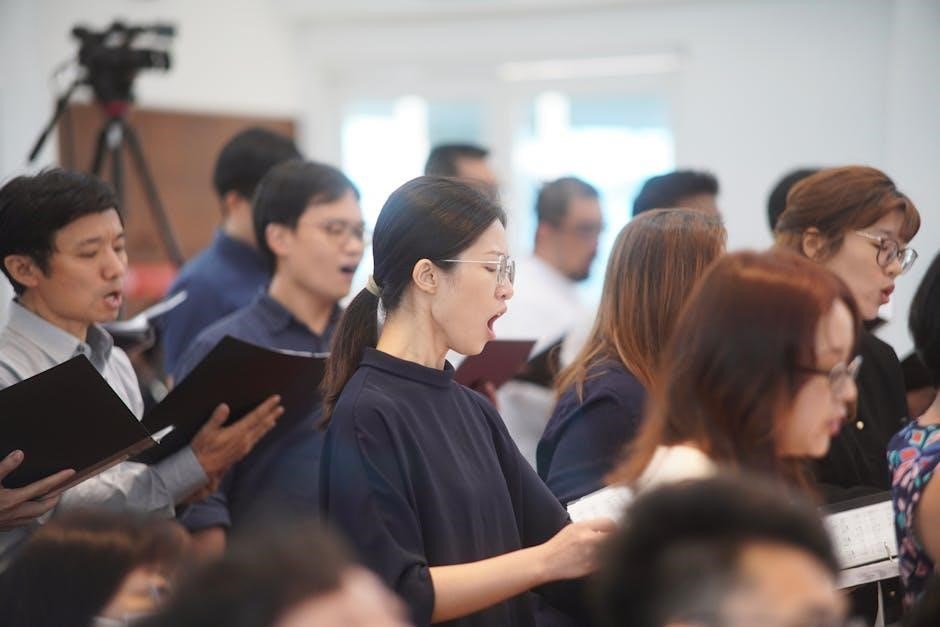sight singing exercises pdf

sight singing exercises pdf
Sight singing enhances musical literacy by training musicians to read and perform unseen notation accurately. It fosters pitch recognition, rhythmic precision, and vocal control, essential for skilled performances.
1.1. Definition and Purpose of Sight Singing
Sight singing is the ability to sing written music accurately upon first reading, interpreting rhythm, pitch, and dynamics without prior practice. Its purpose is to enhance musical literacy, enabling performers to connect with notation directly, fostering confidence and precision in rehearsals and performances. PDF resources like ABRSM and Benedict’s materials provide structured exercises to develop this skill effectively.
1.2. Benefits of Sight Singing for Vocalists and Musicians
Sight singing enhances musical literacy, enabling vocalists to interpret notation accurately and confidently. It improves pitch recognition, rhythmic precision, and vocal technique, fostering overall musicianship. Regular practice boosts performance quality, reduces rehearsal time, and strengthens ensemble cohesion. PDF exercises, such as those from ABRSM and Benedict, provide structured paths to mastery, benefiting both beginners and advanced musicians.

Essential Skills for Effective Sight Singing
Rhythmic accuracy, pitch recognition, and breath control are fundamental. Mastery of these skills ensures clear, confident performances and enhances overall musical understanding and execution.
2.1. Rhythmic Accuracy and Timing
Rhythmic accuracy is vital for sight singing, enabling singers to interpret notation correctly. Start with simple exercises like clapping quarter notes, then progress to eighth notes, dotted rhythms, and syncopation. Practice chanting rhythms before singing to build timing confidence. Resources like ABRSM Specimen Sight-Reading Test Guitar and Masterworks Press exercises provide structured drills for mastery.
2.2. Pitch Recognition and Solfege
Pitch recognition, often taught through solfege syllables (Do, Re, Mi, Fa, Sol, La, Ti), helps singers identify and reproduce musical pitches accurately. Speaking pitch names before singing enhances pitch awareness. Exercises like those in Benedict’s Sight Reading for The Classic and ABRSM Specimen Sight-Reading Test Guitar provide structured drills to refine this skill, ensuring clear and precise vocal delivery.
2.3. Breath Control and Vocal Technique
Breath control is vital for sustained notes and consistent tone in sight singing. Proper diaphragmatic breathing and relaxed vocal technique ensure clear articulation and pitch accuracy. Exercises from resources like ABRSM Specimen Sight-Reading Test Guitar and Benedict’s Sight Reading for The Classic emphasize these techniques, helping singers maintain balance and precision while performing complex melodies.
Step-by-Step Guide to Practicing Sight Singing
- Start by clapping or chanting rhythms to internalize timing.
- Speak pitch names to develop tonal awareness and accuracy.
- Combine rhythm and pitch, gradually increasing complexity.
3.1. Clapping or Chanting Rhythms Before Singing
Clapping or chanting rhythms helps internalize timing before singing. Start with simple patterns like quarter notes, then progress to eighth notes and syncopation. This method enhances rhythmic accuracy and prepares the vocalist for complex sight-singing exercises, ensuring a strong foundation for musical performance and expression.
3.2. Speaking Pitch Names and Identifying Intervals
Speaking pitch names and identifying intervals improves pitch recognition and accuracy. Start with the C major scale, naming notes as you sight-sing. Practice identifying intervals (e.g., major/minor thirds) to enhance harmonic understanding. This skill builds confidence and precision, essential for mastering complex sight-singing exercises and performances. Use PDF resources like Masterworks Press for structured drills.
3.3. Gradual Integration of Rhythm and Pitch
Combine rhythm and pitch by starting with clapping or chanting rhythms, then adding pitch names or solfege. Use exercises from resources like Masterworks Press or ABRSM to practice. Begin with simple melodies in the C major scale, gradually introducing more complex keys and syncopation. This step-by-step approach ensures a strong foundation for sight-singing proficiency and musical fluency over time.

Sight Singing Exercises and Resources
Explore ABRSM, Masterworks Press, and Soundslices for diverse exercises. PDFs like Benedict’s Sight Reading and Choir Sight Singing offer rhythmic drills and melodic studies for all skill levels.
4.1. Recommended PDF Materials for Beginners
Beginners benefit from resources like Benedict’s Sight Reading for the Classic and ABRSM Specimen Sight-Reading Test Guitar. These PDFs offer simple exercises focusing on pitch recognition, rhythmic accuracy, and gradual progression. Additional materials such as Choir Sight Singing.pdf and elementary-level exercises provide foundational skills, ensuring a strong start in sight singing. They are structured to build confidence and technique effectively.
4.2. Advanced Exercises for Skill Mastery
Advanced sight singing PDFs, such as Masterworks Press and ABRSM Sight Singing Grade 1-5, offer complex exercises for refining skills. These materials include challenging rhythms, syncopation, and part singing. Exercises often involve chord progressions and tonal exploration, helping musicians master advanced techniques and achieve polished performances. They cater to experienced vocalists seeking to elevate their sight singing abilities and musical interpretation.
4.3. Interactive Tools and Software for Practice
Interactive tools like Soundslices offer dynamic sheet music for sight singing practice. These platforms allow users to adjust tempos, loop sections, and even assess performances. Such software enhances learning by providing real-time feedback, helping singers refine their pitch accuracy and rhythmic precision. They are invaluable resources for both beginners and advanced musicians seeking to improve their skills effectively.

Common Challenges in Sight Singing
Sight singing often presents challenges like mastering complex rhythms, managing performance anxiety, and maintaining consistent practice to build confidence and accuracy in musical performances.
5.1. Overcoming Rhythmic Complexity
Rhythmic complexity can be challenging in sight singing, but clapping or chanting rhythms before singing helps build accuracy. Breaking exercises into smaller sections and using interactive tools like Soundslices or PDF resources can simplify complex patterns, ensuring mastery over time with consistent practice.
5.2. Managing Nervousness and Performance Anxiety
Managing nervousness in sight singing involves consistent practice and mental preparation. Deep breathing exercises, gradual exposure to challenging pieces, and positive self-talk can reduce anxiety. Using PDF resources like ABRSM Sight Singing materials and interactive tools helps build confidence and familiarity, making performances feel more manageable and less intimidating over time.
5.3. Building Confidence Through Consistent Practice
Consistent practice is key to building confidence in sight singing. Start with simple exercises from PDF resources like Benedict’s Sight Reading and gradually increase difficulty. Celebrate small improvements to stay motivated. Using tools like Soundslices for interactive practice helps refine skills, fostering accuracy and self-assurance. Regular practice reinforces musical literacy and performance readiness.

Assessment and Progress Tracking
Regular evaluations using PDF materials like NYSSMA tests help track progress. Set realistic goals and celebrate small improvements to stay motivated and refine sight singing skills effectively.
6.1. Using Sight Singing Tests and Evaluations
Sight singing tests, like those from NYSSMA and ABRSM, provide structured assessments to evaluate accuracy and fluency. These evaluations often start with a given pitch, such as Do, and include exercises that test rhythm, pitch recognition, and intervals; Regular testing helps identify strengths and areas for improvement, allowing for targeted practice and refined skill development over time.
6.2. Setting Realistic Goals and Celebrating Improvement
Setting achievable goals helps track progress in sight singing. Break exercises into manageable steps, focusing on rhythm or pitch initially. Celebrate small victories, like mastering a complex interval or improving timing. Regularly reviewing progress through journals or recordings fosters motivation and reinforces consistent practice, ensuring steady growth in sight singing proficiency over time.

Sight Singing in Group Settings
Sight singing in groups enhances teamwork and musical coordination. Choirs and ensembles benefit from unified pitch recognition and rhythmic accuracy, fostering a collaborative learning environment for all members.
7.1. Choir and Ensemble Sight Singing Techniques
Choir and ensemble sight singing involves unified techniques like clapping rhythms and using hand signs. Groups benefit from starting with simple exercises, gradually integrating complex melodies. Resources like NYSSMA Level II tests and ABRSM materials provide structured exercises for collective improvement, ensuring alignment and precision among members.
7.2. Collaborative Learning and Peer Feedback
Collaborative learning in sight singing involves group members working together, sharing insights, and learning from each other. This fosters a supportive environment where singers can correct each other and improve collectively. Peer feedback is essential for identifying strengths and areas needing attention, enhancing overall performance and encouraging confidence through constructive input and shared growth.

Sight Singing Exercises for Specific Levels
Exercises are tailored to skill levels, from basic to advanced, focusing on rhythm, pitch accuracy, and dynamics. Resources like PDFs offer structured progressions for each level, ensuring comprehensive development.
8.1. Elementary and Intermediate Exercises
Elementary exercises focus on simple rhythms and pitch recognition, often using hand signs. Intermediate levels introduce syncopation and basic intervals. PDF resources like ABRSM Grade 1-5 provide structured exercises, while Masterworks Press offers reproducible materials for choirs, ensuring gradual skill development from basic to more complex sight-singing challenges.
8.2. Advanced and Professional-Level Challenges
Advanced sight-singing involves complex rhythms like syncopation and polyrhythms, and nuanced pitch recognition. Professional-level exercises often include atonal and chromatic passages. Resources such as Benedict’s Sight Reading and Soundslices interactive tools provide challenging materials that refine accuracy and artistry, preparing musicians for demanding performances and auditions.
Consistent practice and motivation are key to mastering sight singing. Utilize PDF resources and interactive tools to enhance learning and build confidence in your musical journey.
9.1. Staying Motivated and Consistent
Staying motivated requires setting realistic goals and celebrating progress. Engage with diverse sight singing exercises, such as those found in PDF resources, to keep practice fresh and rewarding. Regular use of interactive tools like Soundslices can also enhance enjoyment. Consistency is key, so schedule daily practice sessions, even if brief, to build and maintain skills effectively over time.
9.2. Leveraging Technology for Enhanced Learning
Technology offers innovative ways to enhance sight singing practice. Interactive tools like Soundslices provide real-time feedback, while PDF resources and apps offer accessible exercises. Utilize software for rhythmic drills and pitch recognition. Digital platforms allow for personalized learning, enabling musicians to track progress and refine skills efficiently, making practice more engaging and effective for all levels.
9.3. Seeking Professional Guidance and Resources
Professional guidance enhances sight singing development. Seek experienced teachers or vocal coaches for personalized feedback. Utilize resources like ABRSM sight-singing tests and NYSSMA guidelines for structured learning. Explore materials from publishers like Masterworks Press, offering exercises tailored for various skill levels. These resources provide diverse exercises, ensuring comprehensive skill development and refinement for aspiring musicians of all backgrounds and aspirations.